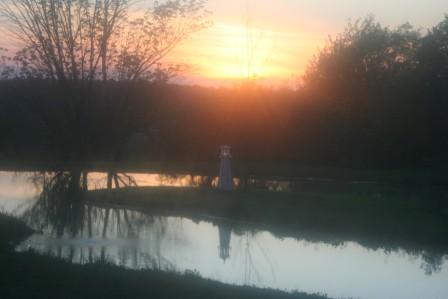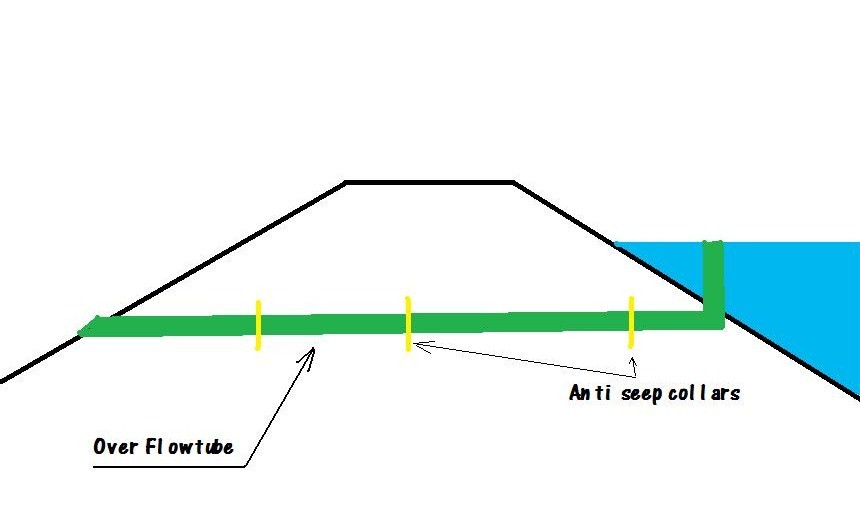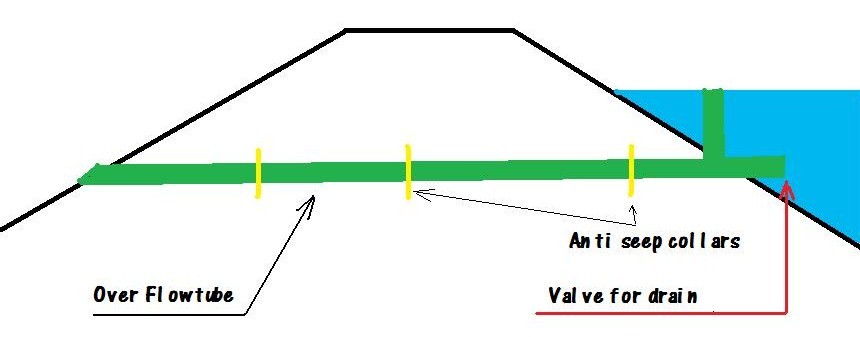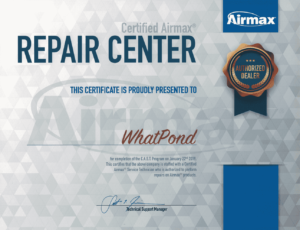 So far we have the watershed side of the pond finished, the bowl or dug out area to hold the water in the pond and now we need to have a way for the excess water leave the pond in controlled way.
So far we have the watershed side of the pond finished, the bowl or dug out area to hold the water in the pond and now we need to have a way for the excess water leave the pond in controlled way.
There are two ways to get the excess water out of the pond safely. One is an overflow pipe (trickle tube) and the other is the emergency spill way. This pipe will keep the pond water level at the height it is set at. And take care of extra rain run off over filling the pond.
The over flow pipe can be done after the pond is done but before the water fills in the pond. This is the easiest way to get the pipe in. There are times that a pond would need to be drained down, repairs if a leak should occur and to help eliminate an over population of unwanted fish. This would be a drain pipe and combined with the over flow pipe. Having a bottom drain will need to be installed before building the dam, then must be watched that it’s not dug up or run over by the dozer. 🙁
At WhatPond we went for the over flow pipe but also made it a drain. The drain would bring the pond water level down 5 feet. Positioned the backhoe on top of the dam and dug a ditch 5 feet down starting at the pond side out to the front of the dam. The ditch should be level to a gradual slope, sloping down and away from the pond. What kind of pipe? The best is plastic with rubber seals such as SDR 35. Using steel will lead to problems later once the steel rusts away. When running the pipe through the dam anti seep collars should be used. Here’s the deal, back to the mashed potatoes clumped on the plate.
Get a straw and pack it in to the pile of mashed potatoes leaving the ends stick out. At first the potatoes
have a little moisture and will adhere to the straw. After a day or so the potatoes will dry out leaving a small space around the straw. This is how water will get out.
The anti seep collar is a tight water seal around the pipe and extends out from the diameter of the pipe. Then the water would travel along the pipe it will
be stopped by this seal and diverted by the collar. Like the straw in the mashed potatoes, as an example of a anti seep collar take masking tape and wrap the straw in two place until it is twice the diameter
of the straw. Now put the straw back in the potatoes and see that it will not slide out as easy.
When installing the pipe there is the horizontal pipe goes through the dam and the vertical is in the pond water. At the intersection of these two pipes two things can happen, one a 90 degree elbow can be installed or a “tee” can be installed leaving an option for a gate valve. This will give the option of draining the pond down to the level of the ditch.
Installing the pipe. Be sure to set the elbow or tee into the dam far enough that it will be buried in the dam. This will keep the vertical pipe up right.
Back filling the ditch and compacting is very important. The use of a tamper is the best way to get the ditch packed in. Rent one or find some one that will come do it for you. There is no other way to pack the ditch in as tight as the tamper. This is going through the dam so it needs to be compacted.
We seem to have run out of space so next week we will get into the spill way.


Comments on this entry are closed.
hey darrell its chris . wen u find clay and put it n a ball then wat ? wen i put the clay ball in a jug of water how long do i leave it in ? and should it be a ball wen i take it out ?
Darrell,
How do you know if the watershed can produce enough water to fill up a newly dug pond?
As a rule of thumb, 2-4 acres of watershed for a 1 acre pond. 90% of ponds are fed by the watershed and few are spring fed. Springs can be helpful and harmful at the same time. Once they give all the water they have and they can act like a drain and pull the water back out of the pond, depending where the spring is located.
In our area we have rain and snow to provide the water collected in the watershed. On average we can see 40-50” of rain and 75-180” of snow to provide the ponds with water.
Our horseshoe pond was first to go in and over the years before the pond went in we diverted all the rain runoff to where the pond ended up, keeping the rain away from the house and barns. If the ground is already saturated and we have a rain event of ½” we end up with one inch in the pond.
The short answer is to have enough acreage in the watershed to collect rainfall, snow cover and be sure the pond is built well with clay to keep the water sealed in.
Darrelll, would a spillway alone be sufficient, if I never planned to drain the pond?
Yes Suzanne, a spillway can be the only exit to the pond, as long as it is big enough to handle the incoming water from the watershed. They say “plan on a 100 rain storm” but I would plan on that ever 5 years. Freak hurricanes, long winters and the heavy rains could all impact the spillway. If you think it is big enough…make it bigger (wider). Plus have plenty of free board in the pond. Such as 2, 4, or even 6′ from the top of the pond to the level of the water where the spillway let’s the water out. This way if there was a lot of snow and melted quick the free board retains the extra water while the spillway let’s the excess water out.
Darrell I have a small pond about 1/4 acre pond that leaks about 6″ a day how can I stop the leak
HI Dave, A leaking pond is a tough problem to solve, finding the leak is the first step and the second would be to cover it with good clay to seal the leaking area. I know this sounds easy but it fact it is hard to actually find the leak. Things to look for is if the water stop leaking and holds at the same level all the time. If so, somewhere around the shoreline could be the culprit area. It could also be the weight of the water pushing out through a deeper porous area due to the weight of the water.
If we are looking at a pond that leaks to the bottom then that area could be the sandy or gravel spot that is allowing water to escape. Even springs that once filled the pond can act as a drain if the spring dried up. The water would reverse, back filling the spring.
Right up front try to find the leaking area, then find clay locally to have hauled in and spread around in that area 6 to 12 inches or more thick. This would be the cheapest fix. The are products that can be used but will cost more in shipping to you and the amount of product would need t o be figured out to get an accurate quote for shipping. One such product to sea the leaking area is, PondSeal Nice product but figure the square footage and multiply by 7 as it needs to be at least 7 pounds per square foot in order to work.
Great information-timely in regards to my ponds situation right now.